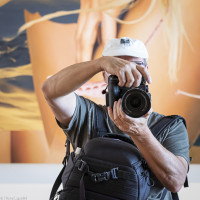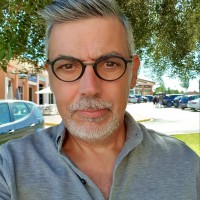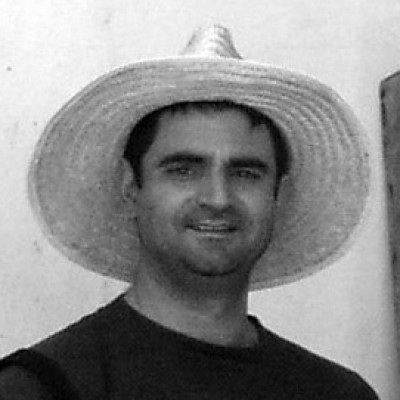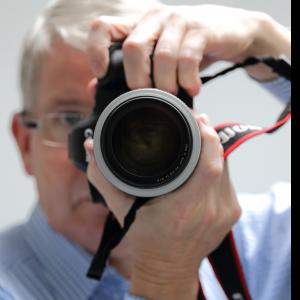SEARCH






|
|
|
|


by Editor Vicente Dolz
I am among those who learnt the flow of digital processing with the books of José María Mellado. For me, they were essential and helped me to share the chemical (analogical) process with the digital one, the film rolls with the sensors.
After reading his first two books (the former was the photography volume most read in Spain), I decided to attend a master class with Mellado, not only because of the “live” learning but also to personally meet José María, so in 2013 I took advantage of a master class he gave in Cabo de Gata (Almería).
From that time on, we have kept our relationship alive (I am delighted for that), since Mellado has taken care of ensuring encounters with his students, even of organising exhibitions of our work.
I also come across him in Iceland. He was giving a private master class and I was on a family trip.
 My family and me with J.M.Mellado in Iceland
My family and me with J.M.Mellado in Iceland
In the interview you can read below, I have tried to escape from the common questions, although I haven’t always achieved so. Why would I like to do without the common questions? Because I have read on the Internet more than a dozen interviews and the usual questions, the classic ones, have already been asked to him.
We will try, if possible, to get to know the most personal Mellado, the Mellado of yesterday and tomorrow.
What are you into now in the photography area?
At the moment, I am promoting my book about Cuba and preparing a future exhibition. After eleven years of visiting the island I decided that it was high time that I picked up all that work together in a publication. Hence that “Cuba. Al otro lado del espejo” (“Cuba. At the other side of the mirror”) was born. In addition, it is an ideal time, as this year (2019) is Havana’s 500th anniversary and it coincides with the celebration of its Biennial of Art.
Concurrently, I continue working on new projects, slightly deviating from my usual line. This is always a risk, but I do not want to get stuck in the same kind of photograph. That is the reason why the exhibition and publishing project CLOSER already entailed a considerable change of tack. I want to go on taking risks.
What is your opinion on international photography? Would you say that, as an art, it has an appropriate recognition? Is it understood differently in each country?
Even though it took long, photography joined, in its own right, worldwide art circuits years ago. However, it is true that in Europe and the United States such acceptance has taken place earlier than, for instance, in South America or Asia.
There are areas of influence where photography has an expression of its own. It is interesting to observe how galleries themselves make very different proposals in Art Basel from those in Art Miami Basel to adapt to the American or European tastes. In art fairs of some countries such as Turkey or China the proposals’ adjustment to the country in question can also be appreciated.
What will be after digital photography? Are we in the “post-photographic” era, as Joan Fontcuberta says?The widespread growth of images we are immersed in, which has been favoured by the democratisation of photography, has undoubtedly changed the rules of the game. Nowadays, there is a wide range of new uses for this discipline and we are adapting to them.
Even so, I do not really agree with some of the approaches of the well-known “post-photography”. For example, with the fact that: “photography has lost its fundamental values such as truth, memory and the archive”, as Fontcuberta asserts. Photoshop is just a new form of image manipulation, but I consider that photography has never represented the truth, and from the very beginning it has been manipulated. It is naïve to believe the opposite.
It is enough to take a look at “The commissar vanishes. The Falsification of Photographs and Art in Stalin's Russia” from David King (very appealing) to check to what extent the so-called truth could be distorted with airbrush, paint brushes and pencils.
What I do believe is that photography has acquired other dimensions previously unimaginable and it has become mature as a main visual language with which the general public is learning to communicate. And I think that is fantastic.
How did you decide to write the first book about photographic technique?
As digital photography bursted into our lives, the transition turned out to be very sudden. It was literally imposed on us (photographers) and not even the brands really knew about the products we were being offered, whilst the industry inexorably set the chemical photography aside.
I felt the need to investigate new tools to achieve similar-quality results to those that chemical photography (I would like to call it “classic”) allowed me to. I showed the results of such research in the form of articles I wrote in some forums such as that managed by Manuel Santos, and I also performed some workshops. As a result of such involvement in sharing my knowledge, some students suggested me to write a book telling all that. And that was how “Fotografía digital de alta calidad” (“High-quality digital photography”) emerged. The title referred to my ultimate goal of achieving the maximum quality with the new tools. That book was successful because it helped many photographers to perform an adequate transition to the digital area.
How many books have you already written?
There may be eight or nine of the technical books. Although some are titled similarly, they have all been written from scratch. I do not have much more left to tell!
Are your books translated to other languages?
I have always wanted to see my books translated, at least, into English, since I believe they would also be successful in other countries. However, that is where the issues of publishers’ marketing and their difficulties to enter the English-speaking market come into play. For the time being, they are only available in Spanish.
Which photographer do you remember to have had an impact on you when you started? Which photographer does impress you now?
I was lucky to enter the Photographic Real Society and to meet the photography icons, like Gabriel Cualladó or Paco Gómez, as well as Eduardo Dea, Castro Prieto or Cristina García Rodero, who were those frequenting Tuesday meetings. I learnt from them, for example, the taste for the copy excellence. Other authors like Cartier-Bresson or Robert Doisneau also had an impact on me during my first stage, when I did black and white reports.
In your opinion, what do you think is the most common mistake made by amateur photographers?
There are different amateurism levels, encompassing from those who start to those who have already achieved excellence. But, in general, a common mistake is to put their focus on cameras and the technique, considering it an aim in itself instead of a vehicle for adequate image expression. Another usual problem is to get that photographs convey emotion.
How had your personal experiences affected your photographs? I mean, do you take a specific type of photo at a particular pessimistic moment and a different kind at an optimistic one?
Yes, indeed. I would even say that my state of mind determines the type of camera I feel like using at each time. And the same happens when treating an image, hence that some of my photographs are dramatic and others very peaceful and minimalist.
If you had to choose only one, which photograph would you say that made you well-known, famous?
That is a very difficult question to answer objectively, so I will mention two of them. During my first stage, it could be “Napias” or some from the series of Industrial archaeology. Once inside the art galleries’ circuits, maybe “Chevy azul y pareja bailando” (“Blue chevy and dancing couple”) was quite iconic. I remember that the complete series was sold in Art Basel with Tomás March gallery.
Is it possible to make a living with photography? Have you achieved so?
It is not easy at all, but I feel it is possible. During decades I have combined my passion for photography with my job in the computer engineering company I own. That allowed me to have the means to progress. Over the past few years I only work as a photographer. Work sale via galleries is complemented with the books and conferences, workshops and master classes I teach.
Still, I have always believed that the best way of enjoying photography is not have to make a living with it.
Regarding cameras, do you still recommend reflex camera?
Not really. The technique has changed a lot. Now I recommend the mobile phone, the mirrorless camera, the classic reflex camera and the half-format cameras. I think these devices are like golf clubs, each of them is for a different thing.
I think that the debate about photo processing is finally over, whether they are processed at a great extent or not. For me, it is a thing of the past. What do you think?
More and more knowledge is arising regarding photography treatment and in which areas it can be done. However, there is still some scatterbrain.
Converting an abandoned petrol station into a beautiful photo, does it have to do with the way of looking or with the processing?
Undoubtedly, it has to do with the way of looking. One of the pleasures I get from photography is to get that you see through my eyes the beauty I find in certain scenarios I come across. The treatment of the image just helps to appropriately express what I have seen and felt.
Which of your photographic stages do you miss? That of black and white social report, industrial archaeology… Are you focused on the landscape right now?
I guess I do not miss anything. And I am looking forward to the next photos I will do. They are stages, parts of a process of personal growth. I affectionately remember when I made street reports with my 70-200 and I carried several TMax 400 rolls (already underway), with different sensitivities (200, 250 y 320), to control the contrast afterwards, when developing them.
The series of Industrial archaeology gave me a lot of satisfaction too. And also when I discovered that I could do the same digitally with colour photos than what I did in the black and white lab.
It seems to me that you are introducing in your landscape or industrial photography the human element in a greater way. Is that true?
That is right. I have gone from industrial landscape photography, urban or nature-like, where the human element is only its footprint, to an approach to the character. And that’s what I am doing…
Will we all end up taking photographs with the mobile phone? Will cameras become cult objects?
I am a strong advocate for taking photographs with the mobile phone. It provides us with a hitherto unknown newness and immediacy. And the quality is more than good. In CLOSER there are two photos in the book and in the exhibition taken with a mobile.
But that does not diminish the space for cameras, at least for now. We simply now take more photos and the mobile is a new tool with which we can communicate via images.
Do you think that vinyl records, film rolls and diesel cars will return?
I am not sure about diesel cars… But vinyl records do have come back. Now it seems that true audiophiles find the maximum quality in vinyl record, and I can bear witness to that fact. And the film rolls, why not? I believe that we should not discard all the possibilities that photographers have to express themselves. The truth is that we can go a long way with the digital tools, but the film roll or a good copy on barite paper detains a special magic that cannot be replicated digitally. They are different means. Why not use them?
Awkward question: Are you going to write more books about Lightroom?
Lightroom Revolution has just been published, five years after the first book I wrote about Lightroom. I have written it since I think that, nowadays, it is the best instrument for the organisation and exploitation of the photographic archive, apart from its capabilities as a developing tool. If in another few years’ time it continues to be the best application for that, I will repeat. Nonetheless, other applications such as Capture One are definitely walking in its footsteps…
 | Write |
 | Thierry Lagandré (Transgressed Light) Very beautiful pictures, and great interview, greetings. |
 | Vicente Dolz Thanks Thierry
|
 | Marco Antonio Cobo PRO Tenía a José María por un docente de esta disciplina fotográfica, ya se dice en este articulo que sus publicaciones en cuanto a procesado de imágenes, son obras de máxima difusión en lengua española, pero cual fue mi sorpresa que en el encuentro anual de la Asociación Fotográfica Rincones de Cantabria, de la que formo parte, descubrí al fotógrafo artista y pude disfrutar de unas jornadas maravillosas. Me ha hecho ilusión ver su entrevista en 1x. En el enlace una pequeña reseña en mi blog de ese encuentro.
https://marcoantoniocobo.com/ix-encuentro-rincones-de-cantabria/
----------------------------
I had José María for a teacher of this photographic discipline, it is already said in this article that his publications regarding image processing are works of maximum diffusion in Spanish, but what was my surprise that at the annual meeting of the Association Photographic Corner of Cantabria, of which I am part, I discovered the artist photographer and I was able to enjoy some wonderful days. I was excited to see your interview in 1x. In the link a small review on my blog of that meeting.
https://marcoantoniocobo.com/ix-encuentro-rincones-de-cantabria/ |
 | Vicente Dolz Encantado de que te haya gustado, Marco Antonio
|
 | Wicher Bos CREW Vincente, thx for making this interview with some very interesting questions and answers!
I enjoyed reading it. |
 | Vicente Dolz Thank you wicherbos!!
|